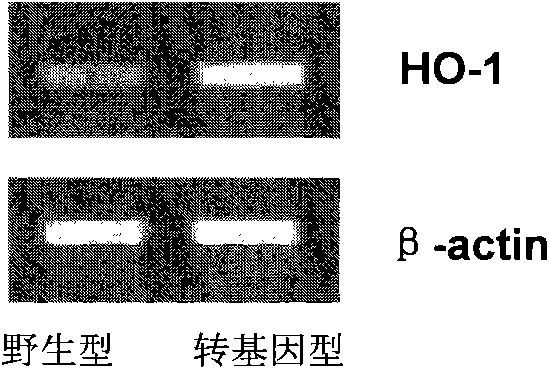Method for establishing Alzheimer disease pathologic model based on transgenic technology
A technology of Alzheimer's disease and pathological models, applied in genetic engineering, plant gene improvement, recombinant DNA technology, etc., can solve problems such as difficult analysis of results, difficulty in AD prevention and treatment, and achieve simple genetic material changes and genetic background clear effect
- Summary
- Abstract
- Description
- Claims
- Application Information
AI Technical Summary
Problems solved by technology
Method used
Image
Examples
Embodiment
[0022] 1. Linear transgene sequence, the sequence contains CMV enhancer from 5' to 3', chickenβ-actin promoter, HO-1 (heme oxygenase 1, heme oxygenase 1) cDNA coding sequence, termination signal rabbitβ-globin poly(A)sequence, such as figure 1 shown;
[0023] 2. Inject the constructed gene sequence into the fertilized mouse eggs by microinjection method;
[0024] 3. Implant the fertilized egg in step 2 into the oviduct of the pseudopregnant mouse;
[0025] 4. Generate FO generation transgenic mice, the exogenous HO-1 expression sequence is integrated in the mouse genome;
[0026] 5. Identify the transgenic mice obtained in step 4;
[0027] 6. Cross the obtained positive transgenic mice with normal mice to obtain offspring;
[0028] 7. Compare the mRNA level, protein level and enzyme activity of HO-1 in transgenic mice and normal mice;
[0029] 8. Analysis of HO-1 overexpression transgenic mice.
[0030] The present invention utilizes transgenic technology to establish a ...
PUM
 Login to View More
Login to View More Abstract
Description
Claims
Application Information
 Login to View More
Login to View More - R&D
- Intellectual Property
- Life Sciences
- Materials
- Tech Scout
- Unparalleled Data Quality
- Higher Quality Content
- 60% Fewer Hallucinations
Browse by: Latest US Patents, China's latest patents, Technical Efficacy Thesaurus, Application Domain, Technology Topic, Popular Technical Reports.
© 2025 PatSnap. All rights reserved.Legal|Privacy policy|Modern Slavery Act Transparency Statement|Sitemap|About US| Contact US: help@patsnap.com



